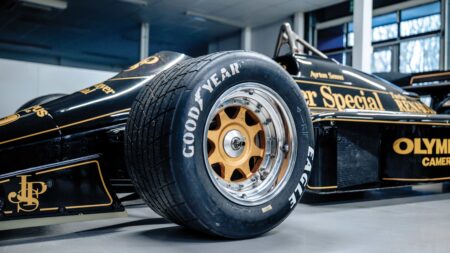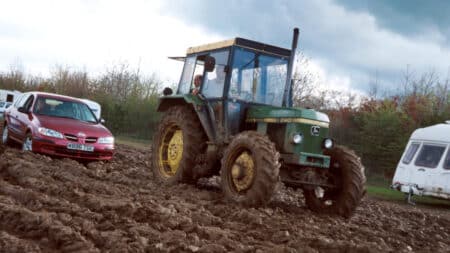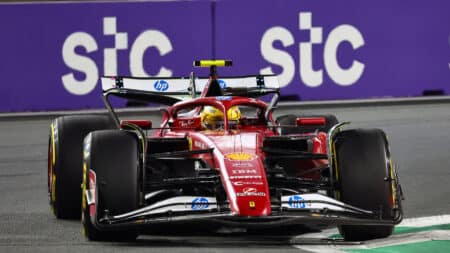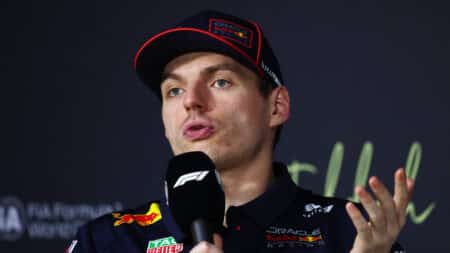
Senna's Lotus 97T: exclusive shoot of F1 legend's first winner
It's 40 years since Ayrton Senna's incredible first F1 win at Estoril – we captured the brilliant grand prix car he did it in for this month's magazine
Qualifying for the Italian Grand Prix was an unprecedented mess but just how did the top teams and drivers in Formula 1 get into such a situation? McLaren race engineer Tom Stallard explains…
Everyone leaves the pit lane at once in the final two minutes of qualifying Photo: Motorsport Images
The final few minutes of Q3 at the Italian Grand Prix were described in a number of different ways. Hilarious, embarrassing, farcical to name but three.
But Formula 1 is an elite sport, and it’s not just the drivers who are supposed to be some of the best in the world. The teams they drive for are full of extremely talented mechanics and engineers. They know what they are doing. So just how did we end up in a situation where nine cars were crawling on their out laps and seven of them failed to start a timed attempt before the chequered flag came out?
Tom Stallard is race engineer to Carlos Sainz at McLaren, and he explains a lot of planning goes into the way qualifying is approached, just like the race itself.
“We have a strategy meeting on Friday night, we have another one between P3 and qualifying, and we’ll normally have gone through it with the driver on Saturday morning,” Stallard says. “So normally the Friday night strategy meeting is no drivers because it’s relatively late, then you’ll confirm with the driver that he’s happy before P3 and then again after P3. Then we have another meeting normally an hour before qualifying where we come up with the plans.
“For us we had the opportunity to use Lando [Norris] a bit to help Carlos in Q2 due to his grid penalty, and then the Q3 plan was just that we knew we wanted to be in a tow.”
To gain time at Monza, the gap to a car in front that drivers are looking for is between three and five seconds in order to get the maximum benefit for a tow. That differs from most circuits where you want to be five to seven seconds behind a car, or in places like Monaco and Singapore where you want to be seven to ten.
“We needed a tow. I think everyone needed a tow. If you compare the lap that Carlos did on his own at the end of Q3 compared with his best laps in Q2 he’s about a quarter of as second off. That’s roughly what you lose by being in completely free air compared to having a four or five-second gap to someone. So everyone was trying to avoid giving up that quarter of a second in Q3. Nobody wanted to go first.”
The shuffling of the pack continues around Curva Grande Photo: Motorsport Images
Almost halfway through Q3 in Italy, Kimi Räikkönen hit the wall at Parabolica and brought out the red flags. The remaining nine cars – both Ferraris, Mercedes, Renaults, Alexander Albon, Lance Stroll and Sainz – returned to the pits until the session restarted with 6min 35sec on the clock.
“I thought Kimi’s crash would stop what happened from happening, because if I’d been a car with no lap on the board at all I would have thought that it wasn’t worth risking not getting a lap,” Stallard explains of the impact of the red flag. “So I would have preferred to lead out and make sure I got there in time.
“If I’d not had a lap time then Carlos would have left the garage possibly as the first car but with a guarantee to make a lap time, so that I could make sure he would have got there in time. Then if you’ve got a chance to let someone through then you would do.
“If you take Stroll, then Stroll’s best lap was still a step behind what anyone else had done and he would qualify behind Kimi if he just sat in the garage, so to me it made sense for Stroll to go. If he’d driven a lap with the pit lane speed limiter on then he would have qualified ahead of Kimi. As it turned out it made no difference because Kimi took loads of penalties but you didn’t know that in Q3. So I thought him and Albon – who also didn’t have a lap – were more likely to go first.
“It was a mess, everyone was aiming at the same thing, which was not to be first.”
While each team and driver wanted to avoid being first out on track, there is also an optimal position in the queue to take up in order to have the best chance of getting a lap in.
I probably shouldn’t comment…but it might be worth you watching the video of one of the top 20 racing drivers in the world missing Turn 1 at 40kph…
“What you want to do is also not be last, because if you’re last firstly you risk missing the flag and also you risk people in front of you causing yellow flags that means you don’t get your lap. So the dream ticket is to be about third in the queue, because you’ve got a good tow, you get to go nicely before the flag and you only have two cars ahead of you that can cause a yellow flag so your risk of that is much lower.
“We went out third. What you do is you fire up quite early and you get the car ready to go and you wait until someone goes and then you jump out after them, essentially. Everyone’s sat there playing poker on how late do I dare go in order to avoid being first?”
With less than 1min 50sec remaining on the clock at Monza, the daring stopped in the pit lane as all nine headed out on track, with Nico Hülkenberg first to join the circuit ahead of Stroll and Sainz.
“Hülkenberg eventually went. I don’t know if his engine got too hot or he thought ‘we can’t wait too much longer than this’ – obviously Renault had two cars to worry about as well. So he left and the stewards decision was that he accidentally missed Turn 1 and went through the run-off, which I probably shouldn’t comment on. But it might be worth you watching the video of one of the top 20 racing drivers in the world missing Turn 1 at 40kph…
“Essentially what happens on the out lap is everyone is trying to get a car in front of them. From Carlos’ perspective there was a genuine effort to just keep in the order that we’d left the pits. So when Stroll in front of him slowed right down because Hülkenberg went off track then it’s just holding the order that you’re in.”
As the field slowed, the margin they all had to make it to the end of the lap before the end of the session was reducing. Suddenly everyone’s playing poker again, working out how late they are willing to risk it until track position is redundant and just getting the lap in becomes the priority.
Related content
“We give information about what the margin is going to be to the flag at the end of the lap, and most of the teams are doing something similar. To tell the driver that the chequered flag is in one minute is pretty useless information. What you want to do is tell him what the time will be once he gets to the flag.
“Some teams do that imagining that the flag is a car on a timed lap that is going to catch them up and some do it based on a normal out lap pace. Again if you listen back to the radio it’s pretty obvious that each team does it a slightly different way but they all do a similar thing.
“Once there’s only ten seconds to the flag catching you Carlos knows that you can’t be trying to not be the first car and you just have to try and be the only car to get across the line. So he was more or less driving flat out from Curva Grande to the start of the timed lap to make sure that we got there. Whereas if you look at the Ferraris, they were worried about which order they would do the lap in and that sort of thing, so they came unstuck.”
The teams of course know how much time they have to play with as they leave the garage, with Stallard explaining they have calculated how late they can head out and do a normal out lap, and what is the absolute latest moment to get round if driving flat out. But once the car is on track, then it comes down to how the driver and his engineer react to the situation.
“A lot of that lap was about communication to the driver. At the start of the lap I told Carlos very clearly what the time was. Then I said something like ‘we’ve got to go now’ around Curva Grande or the second chicane. I think other engineers said similar stuff but I don’t think the drivers realised the severity. By the time we got to Ascari I thought it was touch and go that we’d make it and that nobody else would.
“I then told him something along the lines of ‘defend position’, which sounds like it could be interpreted to mean block people, but if you’re driving flat out it obviously doesn’t. It just means you’re all going for the flag and if you let three people past you then you won’t get a lap. So he was well aware that those were the stakes and I think a lot of other drivers weren’t.
Carlos Sainz behind Sebastian Vettel as the time continued to tick away Photo: Motorsport Images
“As it was, he drove flat out from the second chicane and we opened the lap with 0.4sec to spare. That wasn’t with the full engine mode but was no weaving, taking the racing line and everything else, and we had 0.4sec to spare. So everyone else should have known that if they didn’t do the same they weren’t going to get a lap.
“I think for a lot of people, the time they allowed to do the out lap didn’t allow for the fact there would be cars in front of them. Obviously, if the out lap takes 1min 20sec and you leave with 1min 20sec to go and you’ve got ten cars in front of you, you can’t all just open the lap. So there was a degree of that going on.
“The ideal thing for us would have been for [Charles] Leclerc to have gone first, made the chequered flag ahead of us and we could have made the chequered flag as well and got a tow behind him. As it was, doing the lap on our own with no tow we weren’t able to improve relative to the used tyre run we’d done first.”
As drivers still aimed for an ideal window of between three to five seconds to the car in front for the perfect tow, only Sainz and Leclerc crossed the line to start a timed lap before the session ended, and the latter immediately aborted. The reaction was mixed, but Stallard says it’s simply a unique aspect of that specific venue, and he doesn’t want to see action taken to prevent a repeat.
“To me what happened in Monza in one way was a bit of an embarrassment for the sport, but in another way it was pretty cool. It’s quite dramatic. If that was every event then it would be really annoying, but equally, if Monaco was every event it would be really annoying.
“In Singapore it won’t be a problem because the tow’s a disadvantage there and you want clean air. So I’m not sure that they should necessarily legislate against it. I think if everyone goes and trips each other up then so be it. It shuffles the grid which is normally what they want to do.”

It's 40 years since Ayrton Senna's incredible first F1 win at Estoril – we captured the brilliant grand prix car he did it in for this month's magazine

Twenty-five years ago, the British GP was the subject of a 'prank' by the powers that be as Bernie Ecclestone and Max Mosley made the BRDC hold the race on Easter Sunday. But the chaos that ensued didn't have the desired effect, as Matt Bishop recalls

Lewis Hamilton left Saudi Arabia in a downbeat mood after finishing 30 seconds behind Charles Leclerc. Like in 2024, the Briton is struggling to find answers

The 2025 Saudi Arabian GP delivered a pivotal shake-up in the title battle, as Piastri claimed victory in Jeddah to take the lead the lead in the standings. Here are the main topics from the fifth round of the season